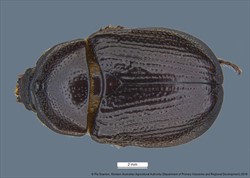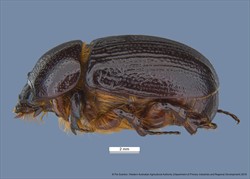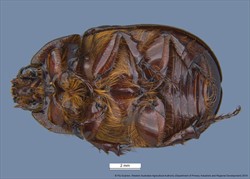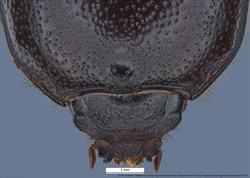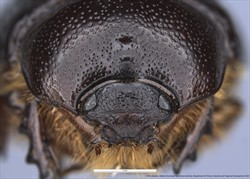Sub family: Dynastinae / Tribe: Pentodontini / Genus: Tomarus
Fact Sheet
Tomarus gibbosus DeGeer, 1774
Small beetles, body length 11.5-16.5mm. Body colouration reddish brown, rarely shiny black. Clypeus truncate, with two denticles on apex corners. Antennae 10-segmented, with a 3-segmented club. Mandibles visible dorsally and with 3 teeth on the outer edge. Mentum with apex truncated. Frontoclypeal suture with a transverse carina (ridge). Pronotum punctate, with a small median tubercle close to the anterior margin. Shallow fovea present behind the tubercle. Foretibia tridentate. Propygidium without stridulatory bands. Tarsal claws simple.
Tomarus gibbosus, the carrot beetle, is considered a pest of a number of cultivated crops such as sugar beets, carrots, potatoes, corn, cotton and sunflowers. Damage to golf course turf has also been reported. Larvae feed on root systems, and adult beetles chew on roots and stems slightly below the soil surface. The beetle has a one year lifecycle. Adult beetles overwinter in the soil and emerge in the Northern Hemisphere spring. Adults are nocturnal and attracted to lights.
The genus is present throughout the American continents, from Canada to Argentina, including the West Indies. Tomarus gibbosus is native and widespread across the United States.
Carrot beetle damage to golf courses reported: https://www.gcsaa.org/gcm/2016/september/first-report-of-carrot-beetle-damage
Ratcliffe, B.C., Paulsen, M.J. 2008. The Scarab Beetles of Nebraska. Bulletin of the University of Nebraska, Vol. 22. 570pp.
Ratcliffe B.C., Cave R.D. 2015 Dynastinae Scarab Beetles of the West Indies. Bulletin of the University of Nebraska, Vol. 28. 346pp.

